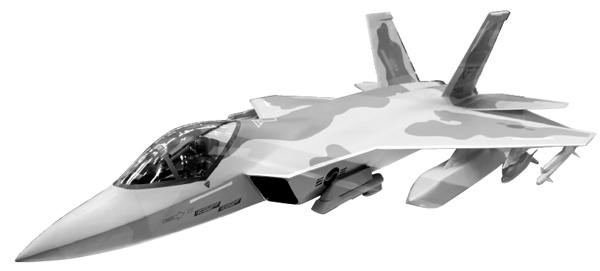Gov’t to begin developing own fighter jets

A model of KF-X fighter jet
“The government will start the Boramae program, code-named KF-X, aimed at producing about 120 fighter jets independently in the country,” Baek Yun-hyeong, a spokesman for the Defense Acquisition Program Administration (DAPA), said at a briefing Sunday.
“This year, we have a new budget to embark on the project, about 20 billion won [$18.7 million], with a goal to develop the jets by 2023 and gradually dispatch them to operations for the next seven or eight years [from 2023].”
The total budget for the 10-year project is estimated to be 8 trillion won, the spokesman said. After completion, about 120 jets will be provided to the Korean Air Force, with an additional 50 going to Indonesia, a primary partner in the program.
The KF-X program has put an end to decade-long controversies surrounding the necessity of South Korea’s own fighter jets and their economic efficiency.
The project was first proposed by former President Kim Dae-jung at the graduation ceremony of the Korean Air Force Academy in 2001, where he proposed to develop state-of-the-art indigenous combat aircraft to replace the KF-16s, which were imported in the 1980s and are the main fighters in the Korean Air Force.
“We already possess the supersonic aircraft T-50 Golden Eagle, and we are developing low-grade combat jets by remodeling the T-50,” Yun said. “Given the fact that we have already imported some light attack jets to Iraq, there would be no problem for us to develop a middle-grade fighter jet.”
Expectations grew that South Korea would be recognized as a leading country in advanced aerospace, not only as one of the world’s top five automakers, officials in Seoul said.
“In the process of developing the new jets, we could face enormous difficulties and frustrations, but after we overcome those potential hurdles, we would accumulate a massive amount of experiences and skills,” said an official at DAPA. “Ten years from now, South Korea would be one of the world’s top aerospace and arms producers along with the United States, Russia and China.”
South Korea expects the indigenous fighter jet program to contribute to job creation. According to a 2012 report by the Agency for Defense Development, the project would employ 90,000 workers at most and have an approximately 41 trillion won ripple effect on involved industries.
Still, industry observers have pointed out that the project’s massive costs could become an issue. Although the Indonesian government has agreed to invest about 20 percent to the development costs, if the project drags on, that figure could escalate to as much as 8 trillion won. The Southeast Asian nation would also have to pay an additional amount for the purchase of the new fighter jets.
Currently, with the development of the country’s first domestic advanced jet T-50, its manufacturer, Korea Aerospace Industries, is preparing additional exports of the supersonic aircraft to the United States, following those to Indonesia and Iraq.
BY JEONG YONG-SOO, KIM HEE-JIN [heejin@joongang.co.kr]










with the Korea JoongAng Daily
To write comments, please log in to one of the accounts.
Standards Board Policy (0/250자)